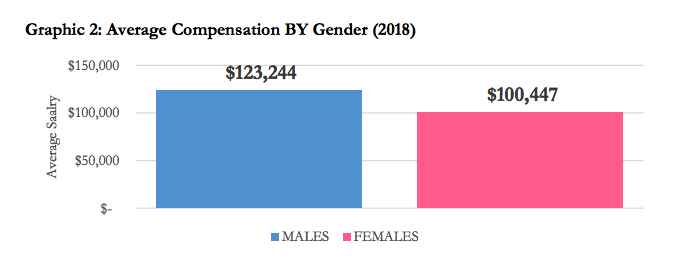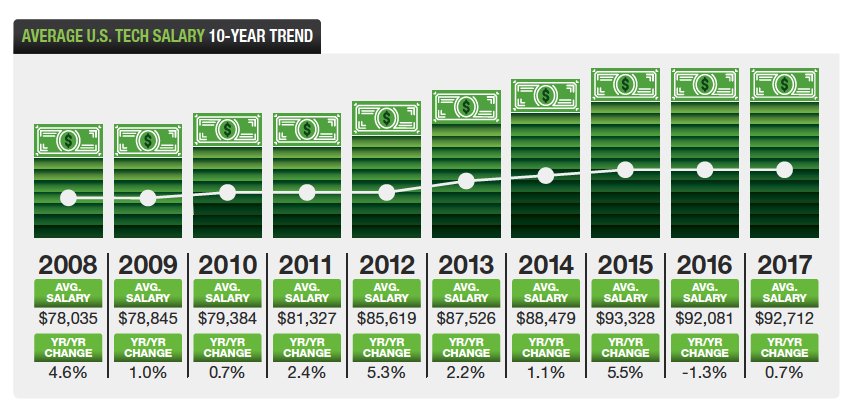The State of Tech Salaries in 2018
 Every year, HIMSS and Dice release surveys on compensation and salaries for professionals in the technology and healthcare IT industries. We’ve pulled the most interesting information from these surveys to understand the state of tech salaries in 2018. Find out who is making the most money in the industry and the skills they have.
Every year, HIMSS and Dice release surveys on compensation and salaries for professionals in the technology and healthcare IT industries. We’ve pulled the most interesting information from these surveys to understand the state of tech salaries in 2018. Find out who is making the most money in the industry and the skills they have.
Below are the highlights and findings from the 2018 HIMSS U.S. Compensation Survey and the 2018 Dice Tech Salary Report.
2018 HIMSS U.S. Compensation Survey
885 U.S. health IT professionals participated in this year’s survey. The average salary for digital health professionals is $109,610. Per HIMSS, this is a modest increase over 2017 and generally consistent with former years and survey findings.
See Our Latest HIT Jobs
The most interesting aspects of the survey are the salary disparities that exist based on gender and race. The pay disparity is persistent especially for females and non-white professionals.
These are the key findings related to gender from the survey:
- Females make an average 18% less than their male peers.
- It can be said from this survey that females are paid $0.82 for every $1.00 a male is paid since the average salary for females is $100,447 and the average salary for males is $123,244.
- Older females experience greater pay disparities than their younger coworkers.
- Female health IT professionals working in the South and West tend to experience greater pay disparities than females working in other areas of the country.

These are the key findings related to race from the survey:
- For the purpose of the survey results, race was grouped into two categories—”white” and “non-white”.
- Non-white health IT professionals make on average 12% less than their white counterparts. The average salary for white respondents was $112,926 and the average salary of non-white respondents was $99,069.
- Older, non-white information and technology professionals experience greater pay disparities.
- The pay gap for non-white digital health professionals was the least in hospital settings (8%), especially in for-profit hospitals.
2018 Dice Tech Salary Report
The Dice Tech Salary Report is one of the most popular sources for year-over-year salary data trends. It breaks out salaries by technical skills, industry, and cities in the United States and show which technology skills are in the highest demand. Let’s dive into this year’s findings.
10,725 employed technology professionals participated in this online survey. The annual salary for all of these technology professionals in the United States in 2017 was $92,712, only a 0.7% increase from 2016. Overall, average salaries remained flat, but the survey showed that employers are using other tactics, such as incentives and benefits, to compensate employees and attract top talent.

Here are some of the key findings from the 2018 Dice Tech Salary Report report:
- The average contract rates rose five percent from 2016 to $72.32 per hour.
- 42% of tech pros anticipate changing employers in 2018 for higher compensation, better working conditions, or more responsibility.
- The top metro cities for salary were Silicon Valley ($114,654/year), Boston ($105,329/year), New York ($103,941/year), San Diego ($101,025/year), and Washington D.C./Baltimore ($99,937/year).
- These were the top salaries by job title:
- Tech Management (CEO, CIO, CTO, VP, Director) – $136,786 per year
- Systems Architect — $135,082 per year
- Product Manager — $119,141 per year
- Tech Management (Strategist, Architect) — $117,748 per year
- Project Manager – $114,136 per year
Dice said the top paying skills included big data, cloud technology, automation, process and project management, storage, databases, and programming languages.
Compensating Employees with Bonuses & Benefits
Even though tech salaries have remained steady with minimal increases year-over-year, companies are using incentives like bonuses and benefits to compensate employees and attract top talent. Both surveys found an increase in these strategies and respondents reported receiving more perks and benefits.
According to the Dice Tech Salary Survey, 71% of respondents received one of the following perks:
- Increased compensation
- Flexible work location/telecommunication
- Flexible work hours
- More interesting or challenging work
- Training and certification courses
- Promotion of new titles
The Dice survey also found that in 2017, a third of tech professionals received a bonus, earning on average $10,254. In the healthcare IT space, the 2018 HIMSS U.S. Compensation Survey found that employers appeared to favor bonuses as a compensation incentive for those with managerial responsibilities.
One of the most interesting findings in Dice’s salary survey was that 60% of tech professionals said they would like to work remotely half of the time or more, but only 22% currently do. They value this perk so much that that 63% of respondents said they would take a pay cut to telecommute at least half of the time!
As salaries continue to stay at a steady pace in the IT industry, perks and benefits are becoming a popular trend and valued by employees. Organizations looking to differentiate themselves to attract top talent can take these strategies into consideration in order to build a professional and competitive workforce.